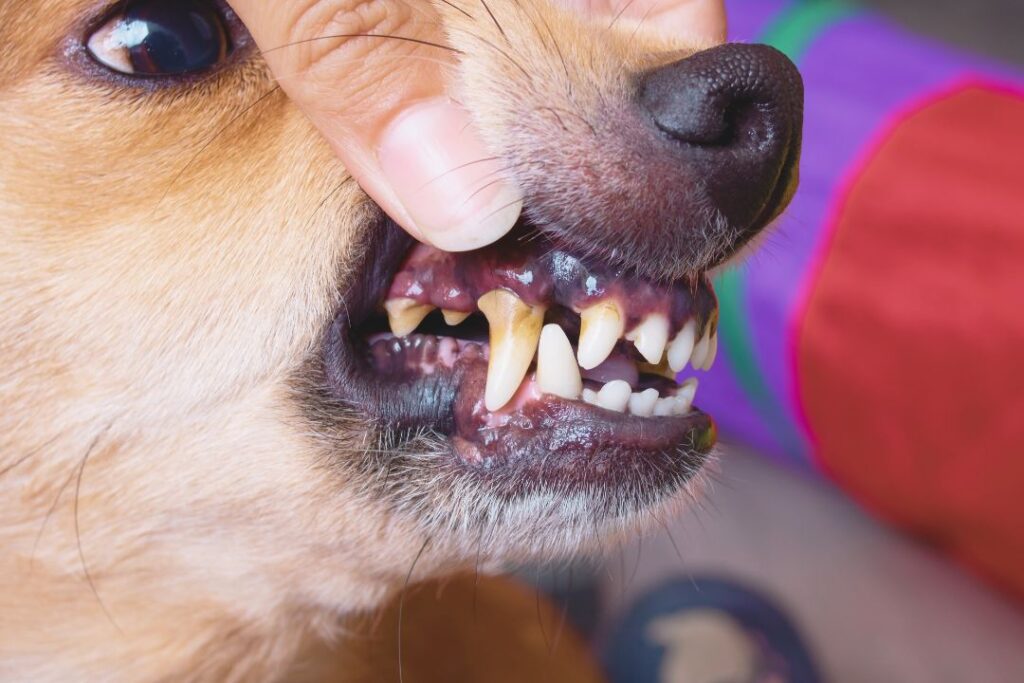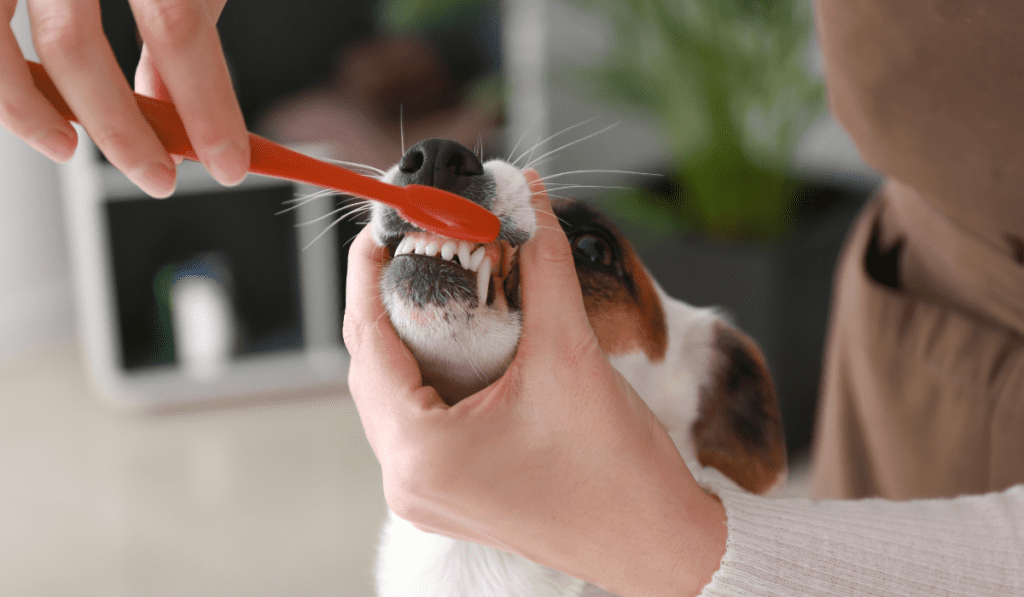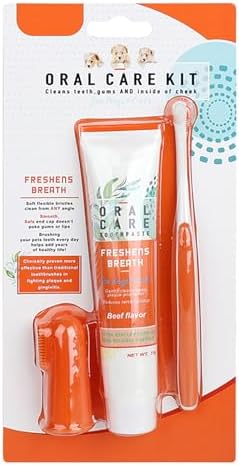You should never brush a dog’s teeth with human toothpaste. The question, “Can dogs use human toothpaste?” has a clear answer: no. Human toothpaste contains ingredients that can be harmful if swallowed, such as high levels of sodium or xylitol, which is an artificial sweetener toxic to dogs. Ingesting these ingredients can lead to upset stomachs, digestive issues, or even more severe health problems for pets. Therefore, it’s important to avoid using human toothpaste when caring for your dog’s dental hygiene. Instead, opt for toothpaste specifically designed for dogs.
Can Dogs use human toothpaste?
It is not safe to use human toothpaste on dogs. Human toothpaste contains ingredients such as sodium, fluoride, and xylitol, which can be harmful or even toxic to dogs if swallowed. These substances may lead to upset stomachs, digestive issues, and severe health problems. Instead, consider exploring ways to keep your dog’s teeth clean without a toothbrush, such as safer alternatives to maintain your pet’s oral health.
The Risks of Human Toothpaste for Dogs

Human toothpaste is formulated with ingredients safe for human consumption but harmful to dogs. Ingredients like fluoride and sodium, common in human toothpaste, can lead to severe health issues if ingested by dogs.
- The artificial sweetener xylitol, found in many human toothpastes, is particularly dangerous as it is highly toxic to dogs and can cause rapid insulin release, leading to hypoglycemia (low blood sugar). Ingesting xylitol can lead to vomiting, loss of coordination, seizures, and even liver failure.
- Human toothpastes also often contain foaming agents and detergents not intended to be swallowed. These ingredients can irritate a dog’s stomach lining and cause gastrointestinal distress.
- Even if your dog doesn’t immediately show symptoms, long-term exposure to these substances can lead to chronic health issues. Therefore, avoiding using human toothpaste when brushing your dog’s teeth is crucial.
Common Periodontal Disease in Dogs

It’s estimated that over 80% of dogs over three suffer from periodontal disease, an inflammation or infection of the tissues surrounding the teeth. This condition begins as gingivitis, caused by plaque accumulation, and can progress to involve the bony tooth sockets.
Plaque forms as an accumulation of bacteria on the teeth within hours after eating or undergoing a professional cleaning. Within a day, plaque combines with minerals in saliva to form tartar (calculus).
If left untreated, periodontal disease can lead to painful tooth loss and other severe health problems. Regular dental care is crucial to prevent this common and potentially serious condition.
Periodontal disease not only affects the teeth but can also have systemic effects on a dog’s overall health. Bacteria from the mouth can enter the bloodstream, leading to infections in other organs such as the heart, liver, and kidneys.
This can exacerbate existing health conditions and reduce a dog’s quality of life. Therefore, maintaining good oral hygiene through regular brushing and professional dental cleanings is essential for your pet’s overall well-being. Now you know the answer to “Can you brush a dog’s teeth with human toothpaste?”
When Should I Brush My Dog’s Teeth?
Ideally, you should brush your dog’s teeth at least twice daily, just as you would your own. For many dogs, regular brushing can become an expected and enjoyable part of their routine. If daily brushing is not feasible, brushing at least three times a week is the minimum recommendation to help remove plaque and prevent tartar buildup.
Regular brushing helps remove plaque before it hardens into tartar, which is more difficult to remove and requires professional cleaning. The frequency of brushing depends on your dog’s individual needs, such as age, breed, and overall dental health.
Puppies may benefit from more frequent brushing to acclimate them to the process and establish good habits early on. Older dogs may require more frequent brushing to manage existing dental issues and prevent further deterioration of oral health.
Teaching Your Dog to Accept Tooth Brushing

Teaching your dog to accept tooth brushing is a gradual process that requires patience and positive reinforcement. Start by introducing your dog to tooth brushing in a calm and positive environment. Use rewards such as treats and praise to create a positive association with the experience. Here are steps you can follow to teach your dog to accept tooth brushing:
1. Make It Positive
To ensure success, make tooth brushing a positive experience for you and your dog. Begin by getting your dog accustomed to having their mouth and teeth touched. Gently lift their lips to expose their teeth and gums, rewarding them with praise and treats for cooperation.
2. Choose a Quiet Time and Place
Start brushing your dog’s teeth in a quiet, comfortable location. If your dog is small, hold them securely in your lap with their head facing you. For larger dogs, sit on a chair and have your dog sit beside you so you can comfortably handle their mouth and teeth.
3. Start Slowly
Begin by gently rubbing your finger or a soft cloth over the outer surfaces of your dog’s teeth, using a back-and-forth motion. Focus on the area where the gum touches the tooth surface. Stay on the outside surfaces of the teeth to avoid accidental bites. Rub only a few teeth for the first few sessions, especially if your pet is unsure or nervous.
4. Introduce Pet Toothpaste
Once your dog is comfortable with you rubbing their teeth, let them taste a small amount of pet toothpaste from your finger. Remember, do not use human toothpaste, as it can be harmful for your dog. Dog toothpaste is specifically formulated to be safe for swallowing and often comes in flavours that dogs enjoy.
5. Progress to a Toothbrush
Once your dog is accustomed to the taste of pet toothpaste, apply a small amount onto a cloth and gently rub it over their teeth. Gradually introduce a toothbrush specifically designed for dogs. You can start with a finger brush or a soft-bristled brush made for human babies.
6. Choosing the Right Toothbrush
Commercial toothbrushes designed for dogs come in various styles, including:
- Brushes with angled handles
- Brushes with multiple heads to simultaneously brush all tooth surfaces
- Small brushes that fit comfortably in your hand
- Finger toothbrushes that fit over the tip of your finger
The type of toothbrush you choose should match your dog’s size and your comfort level. Finger brushes are often easier to use when starting out. Always be gentle and take your time to avoid irritating your dog’s gums.
Can You Use Baking Soda?
No, baking soda is not recommended for brushing your dog’s teeth. Baking soda’s high alkaline content can disrupt the acid balance in your dog’s stomach and digestive tract if swallowed, potentially leading to gastrointestinal issues.
Moreover, baking soda has a bitter and unpleasant taste, which can cause your dog to resist or become uncooperative during tooth-brushing sessions. Unlike specially formulated dog toothpaste, baking soda does not provide additional benefits such as appealing flavors or ingredients designed to promote oral health.
Using products specifically for dogs ensures safety and effectiveness, making the tooth-brushing experience more pleasant and beneficial for your pet. Therefore, avoiding baking soda and opting for veterinary-approved dental care products is best.
Why Use Pet Toothpaste?
Pet toothpaste is specifically formulated for dogs and is safe to swallow. It comes in flavors that dogs find appealing, such as poultry, beef, malt, and mint. Using a flavored product can make the brushing experience more enjoyable and less stressful for your dog.
Pet toothpaste also contains enzymes and other ingredients that help reduce plaque and tartar buildup, promoting better oral health. When choosing a pet toothpaste, look for products accepted by the Veterinary Oral Health Council (VOHC).
The VOHC seal ensures that the product meets rigorous standards for quality and effectiveness. This assurance helps pet owners select the best dental care products, contributing to their dogs’ overall health and well-being.
How to Brush Your Dog’s Teeth?
Step-by-Step Guide
Brushing your dog’s teeth is crucial for their oral health. This guide covers steps to make the process easier and more effective, from choosing the right tools to creating a positive experience for your pet and ensuring clean and healthy teeth.
- Apply Toothpaste: Apply a small amount of dog toothpaste to the toothbrush.
- Raise Lips: Gently raise your dog’s lips on one side of their mouth. You can do this by pushing up on the lip with your finger or placing your hand over your dog’s head with your thumb and index finger on opposite sides of their upper jaw.
- Open Mouth: To brush the lower teeth, gently tilt your dog’s head backward while holding their upper jaw.
- Focus on Cheek Teeth and Canines: Concentrate on brushing the large cheek teeth and canine teeth, where plaque and tartar accumulate most quickly. Gradually work up to brushing all teeth, which may take several days or weeks.
- Outside Surfaces: Focus on the outer surfaces of the teeth, as periodontal damage primarily occurs there. The dog’s tongue naturally helps clean the inner surfaces of the teeth.
Duration
Aim to brush your dog’s teeth for approximately 30 seconds per side. This duration allows you to cover all areas effectively without overwhelming your dog.
Additional Tips
- Wear Gloves: A dog’s mouth contains bacteria, so wearing gloves can protect you. If gloves limit your ability to brush effectively, thoroughly wash your hands with soap and water afterward.
- Rinse and Replace: Rinse the toothbrush thoroughly after each use and replace it every three months. Use a separate toothbrush for each dog if you have multiple pets.
Conclusion
Human toothpaste is unsafe for dogs due to harmful ingredients that can cause digestive issues or toxicity. Instead, use pet toothpaste and toothbrushes designed for dogs. Regular brushing is essential to prevent periodontal disease, which affects many dogs over three years old.
By making tooth brushing a positive experience and following the recommended steps, you can ensure your dog’s teeth remain healthy and strong, contributing to their overall well-being.
Regular dental care is a vital part of your dog’s health routine, and using the right products and techniques can make a significant difference in their oral hygiene. Hope your query is clear: “Can you brush a dog’s teeth with human toothpaste?”!




